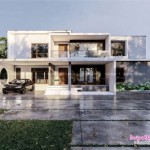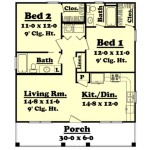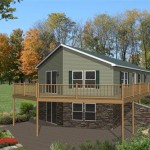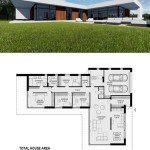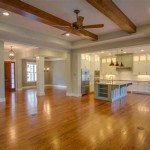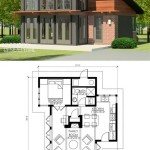One Bedroom One Bathroom House Plans: Maximizing Space and Functionality
One bedroom one bathroom house plans represent a popular choice for individuals and couples seeking compact, efficient, and cost-effective housing solutions. These plans are particularly well-suited for first-time homebuyers, downsizing retirees, or individuals prioritizing location and lifestyle over expansive square footage. The appeal lies in the balance of affordability, manageability, and the inherent design challenges of creating a comfortable and functional living space within a smaller footprint. This article will explore the considerations and strategies involved in crafting effective one-bedroom, one-bathroom house plans, focusing on optimizing space, functionality, and overall livability.
Understanding the Target Audience and Their Needs
Before embarking on the design process, it's crucial to identify the intended user. A single professional, a young couple, or a senior citizen will have vastly different needs and expectations for their living space. For instance, a younger professional might prioritize a dedicated home office area and ample storage for gadgets and recreational equipment. Conversely, a retired individual might value accessibility features, a low-maintenance design, and a comfortable, easily navigable layout. A young couple might prioritize a larger, more flexible living area for entertaining and future expansion possibilities, such as a convertible den or home office.
Understanding the intended user's lifestyle is also critical. Do they frequently entertain guests? Do they work from home? Do they have hobbies that require dedicated space? Answering these questions will inform design decisions regarding the size and configuration of the living area, kitchen, and bedroom. The answers will also influence choices concerning storage solutions and the integration of multi-functional spaces.
Budget constraints are often a significant factor when considering a one-bedroom, one-bathroom house plan. Efficient design can minimize construction costs by reducing the overall footprint and simplifying the building process. Consider incorporating cost-effective materials and construction techniques without sacrificing durability or aesthetic appeal. Prioritize essential features and opt for streamlined designs to stay within the allocated budget.
Designing for Optimal Space Utilization
The key to successful one-bedroom, one-bathroom house plans is maximizing every square foot. This requires a thoughtful approach to layout, furniture selection, and storage solutions. Open-concept designs are highly beneficial in smaller spaces, as they create a sense of spaciousness and allow for flexible use of the living area, dining area, and kitchen.
Strategic furniture placement is essential. Choose furniture that is appropriately scaled to the room size. Avoid bulky or oversized pieces that will overwhelm the space. Consider multi-functional furniture, such as sofa beds, storage ottomans, and folding tables, to maximize utility. Wall-mounted shelves and cabinets can provide ample storage without taking up valuable floor space.
Vertical space is often underutilized in smaller homes. Tall bookshelves, high cabinets, and lofted storage areas can significantly increase storage capacity without sacrificing floor area. Consider incorporating built-in storage solutions, such as under-bed drawers, window seat storage, and recessed shelving, to seamlessly integrate storage into the design.
The bathroom, despite its small size, requires careful planning. Wall-mounted sinks and toilets can save floor space and create a more open feel. A shower instead of a bathtub is another space-saving option. Mirror placement can also contribute to the illusion of a larger space; a large mirror can reflect light and visually expand the room. Proper ventilation is especially important in a small bathroom to prevent moisture buildup and mold growth.
The bedroom benefits from similar space-saving strategies. A platform bed with built-in storage is an excellent choice for maximizing space. Minimalist décor and a neutral color palette can create a sense of calm and spaciousness. A well-organized closet with adjustable shelving and hanging rods is essential for optimizing storage within the bedroom.
Key Considerations for Functionality and Livability
Beyond maximizing space, functionality and livability are paramount in creating a comfortable and enjoyable living environment. This encompasses aspects such as natural light, ventilation, privacy, and accessibility.
Natural light is crucial for creating a bright and welcoming atmosphere. Maximize the size and number of windows to allow ample sunlight to enter the home. Consider skylights or solar tubes to bring natural light to areas that may not have direct access to windows. Proper window placement can also optimize natural ventilation, reducing the need for air conditioning.
Privacy is another important consideration, particularly in a one-bedroom home where living and sleeping areas are often in close proximity. Consider incorporating soundproofing measures, such as insulated walls and solid-core doors, to minimize noise transmission. Window coverings, such as blinds or curtains, can provide privacy from neighbors and street traffic.
Accessibility should be a primary concern, regardless of the target audience. Wider doorways, grab bars in the bathroom, and a zero-threshold shower can enhance accessibility for individuals with mobility limitations. Even if accessibility is not immediately required, incorporating these features can future-proof the home and increase its long-term value. Consider the ease of navigating the space with furniture and potential mobility aids.
Adequate storage is also vital for maintaining a clutter-free and organized living environment. Plan for storage solutions for clothing, linens, kitchenware, cleaning supplies, and personal belongings. Consider dedicated storage areas, such as a linen closet or a pantry, to keep the home organized and functional. Outdoor storage, such as a shed or deck box, can be valuable for storing seasonal items and gardening equipment.
Kitchen design should prioritize efficiency and functionality. Compact appliances, such as a built-in microwave and a slimline dishwasher, can save space without sacrificing performance. A well-designed kitchen layout with ample counter space is essential for food preparation. Consider incorporating pull-out shelves and drawers to maximize storage and accessibility.
Integrating Outdoor Space
Even in a small home, incorporating outdoor space can significantly enhance the overall living experience. A patio, deck, or balcony can provide a relaxing retreat and extend the living area. Outdoor space can also be used for entertaining, gardening, or simply enjoying the fresh air.
A small patio or deck can be easily integrated into a one-bedroom, one-bathroom house plan. Choose durable and weather-resistant materials, such as composite decking or concrete pavers. Consider adding outdoor furniture, such as a table and chairs, to create a comfortable seating area. A small garden or container plants can add a touch of greenery and create a more inviting atmosphere.
A balcony is an excellent option for apartments or homes with limited ground space. A balcony can provide a private outdoor space for relaxing and enjoying the view. Consider adding a small table and chairs, a container garden, or a privacy screen to enhance the functionality and privacy of the balcony.
When designing outdoor space, consider the orientation of the home and the prevailing weather conditions. Orient the outdoor space to maximize sunlight exposure and minimize wind exposure. Consider adding shade structures, such as an awning or pergola, to provide protection from the sun and rain. Also consider the accessibility of the outdoor space from the interior of the home; a seamless transition between indoor and outdoor living can significantly enhance the overall enjoyment of the space.
Furthermore, landscaping can play a crucial role in enhancing the aesthetic appeal and functionality of the outdoor space. Choose plants that are appropriate for the climate and soil conditions. Consider incorporating low-maintenance landscaping options, such as native plants and drought-tolerant ground cover. A well-designed landscape can provide privacy, shade, and visual interest, creating a more enjoyable and relaxing outdoor environment. Outdoor lighting can also enhance the usability and safety of the outdoor space, allowing for nighttime use and deterring intruders.

With 1 Bed 2 Bath One Bedroom House Plans Small Floor

Ranch Style House Plan 1 Beds Baths 896 Sq Ft 771 One Bedroom Plans Small Floor

1 Bedroom Floor Plans Yahoo Search Results Small House Guest One

30x24 House 1 Bedroom Bath 720 Sq Ft Floor Plan Small Plans One Tiny

One Bedroom House Plans For Starter Homes Ck

Custom Granny S Tiny House Plans 24 X27 1 Bed

1 Bedroom Apartment House Plans

Truoba Mini 117 Modern House Plan 924 7

30x20 House 1 Bedroom Bath 600 Sq Ft Floor Plan Instant Model 4a

One Bedroom House Plans For Starter Homes Ck

